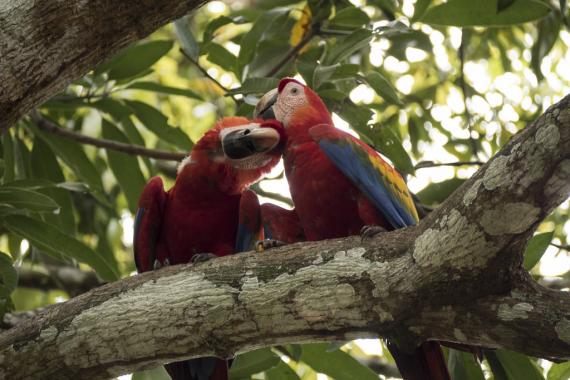Reintroducing scarlet macaws in Mexico
Published

Pair of scarlet macaws. ("CostaRica_20161113_118" by QuiRag is licensed under CC BY-NC 2.0)
Scarlet macaw numbers have greatly reduced in Mexico due to habitat loss and poaching of eggs, chicks and live birds for the illegal pet trade. In 2013, an organisation called Bosque Antiquo AC and partners launched a project to conserve the birds in Los Tuxtlas Biosphere Reserve. The project aimed to reforest scarlet macaw habitat and reintroduce birds into the wild. To date over 130 birds have been reintroduced and the project has engaged local communities to develop sustainable livelihoods through ecotourism and other activities.
Lead

Location
The Los Tuxtlas Biosphere Reserve covers an area roughly 90km long and 50km wide. It consists mainly of jungle and is extremely biodiverse. Over one hundred communities live on the edges of the reserve, with agriculture the primary form of livelihood.
The poaching and wildlife trade problem
Species affected Scarlet Macaw Ara macao
Products in tradeScarlet macaw eggs and live birds are captured for illegal national and international pet trades.
Overview of the problem
Scarlet macaws are threatened by excessive poaching for the illegal pet trade, driven by high demand and economic value. This pressure has already led to local extinctions over much of the bird’s original range.
The anti-IWT initiative
A reintroduction project was implemented in 2013 with the goal of creating a self-sustaining population of 500 wild birds by 2026. Part of the project is to work with the local communities to create a sense of ownership and to help develop sustainable initiatives. Pilot programs and training with communities in activities such as ecotourism and beekeeping are intended to provide additional sources of revenue whilst having a reduced environmental impact.
The strategy
Increasing incentives for wildlife stewardship
Increasing livelihoods that are not related to wildlife
Build/and or support sense of community ownership or stewardship
Has the initiative made a difference?
Over 130 macaws have been reintroduced with 85% of them surviving. In 2018 the first chick was born in the wild in Mexico for 50 years. Reforestation of 50 hectares of land has provided macaws with additional habitat and also created a landscape that will provide future economic benefits to communities.
What works and why
The success of the project has largely been down to how it has engaged local communities to be part of the long-term solution for conserving macaws.
Factors for success
Devolved decision-making power so local communities have a voice in creating or co-creating solutions (as part of the initiative)
Organisers, donors and partners
The U.S. Fish and Wildlife Service has supported this project with several grants.
For further information contact (peoplenotpoaching@gmail.com).